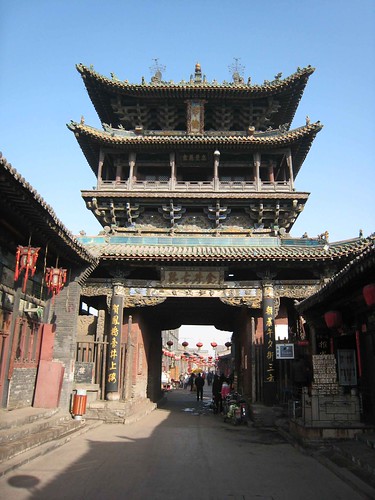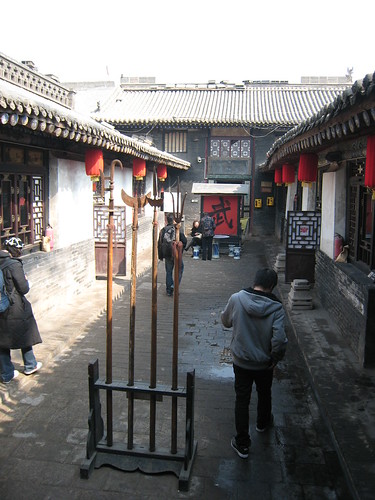 At 5:30am, the ancient town of Pingyao is a black mass that disappears in the darkness. There are no signs of street lights, save for the few red lanterns that dangle outside these still sleeping homes. The alleys here seem more like one long labyrinth, a giant shadow the seeable destination. Very quickly, I wonder where I am and if I might get mugged.
At 5:30am, the ancient town of Pingyao is a black mass that disappears in the darkness. There are no signs of street lights, save for the few red lanterns that dangle outside these still sleeping homes. The alleys here seem more like one long labyrinth, a giant shadow the seeable destination. Very quickly, I wonder where I am and if I might get mugged.
A few hours later, Pingyao begins to awake. And soon I find that nothing here resembles the modern China I know.
There are no high-rises in sight. No bustling shopping malls within town. In fact, theres hardly anything over three stories tall.
Instead, Pingyao likes to thrive on the old, having become one of the most well-preserved medieval towns in the country. All around the vicinity are hundreds of buildings that date back to the Ming and Qing dynasties (1368 to 1911). Ancient temples and businesses-turned-museums line up against the major streets, while restaurants and shops take up residence in historical buildings. Even the hotel I stay in is several hundred years old.
The timeless quality of Pingyao comes after the government and preservationists have worked to protect the architecture and atmosphere of the town. In 1986, China named it as a historical and cultural city. Eleven years later, it became a UNESCO World Heritage Site. As a result, very few cars are allowed to even enter the town. (Residents generally get around riding bikes or using motorcycle towed carriages).
Pingyao, a town of 490,000 people, is located in Shanxi province, and has a history that extends back to the Western Zhou period (1045 to 771 BC). At its earliest stage, Pingyao was simply some city walls. But now those walls have become a defining feature for the town.
In 1370, the Ming Dynasty emperor Hongwu built what is now the current incarnation of Pingyaos city walls. They measure up to around 11 meters high and are laid with stacks of brick. On a map, the walls form a square, but their layout has been described to be shaped as a turtle; the so-called head and tail, acting as both the southern and northern gates, with the four legs forming the gates on both the east and west sides.
 Standing on top of the wall, one can see how well Pingyao is preserved as a whole.
Standing on top of the wall, one can see how well Pingyao is preserved as a whole.
Every building looks as if it could have been designed by the same architect, each structure built with matching bricks and sloping roofs.
But while the wall was meant to defend the town from enemies, it now seems to keep out the modernization sweeping China. Just outside the walls are a jumble of crowded office buildings, billboard signs featuring fashion models, and a spattering of parked cars; the scene looks anything but consistent.
In its heyday Pingyao was also the major financial center for all of China during the late Qing Dynasty. At one point, a total of 22 banks were located in the town. With ingots of silver acting as the currency, the banks were forced to employ armed escorts to protect the transportation of goods.
Though the banks have long gone bankrupt brought down by political turmoil and competition from foreign banks during the early 20th century a few of them now exist as museums. One of them includes Chinas very first bank, Rishengchang or Sun Rising Over Prosperity, which was established in Pingyao in 1823 and survived for nearly a century. The bank has been restored, with many of the rooms looking as they did when the place was still in operation. Old bank notes are on display, as well as the abacuses accountants used to calculate finances. 
At other museums in Pingyao, I had a chance to peer inside one of the storerooms used to house the silver ingots. For a brief moment, I even wielded an old Chinese halbeard (a pole-like weapon) as I visited one of the buildings where bank bodyguards worked from.
Even as Pingyao strives to entrench itself in the past, the efforts to preserve Pingyao have led it to become a major tourist destination in recent years. Souvenir shops make up many of the businesses in this town. At the same time, nearly all restaurants display the same English labeled menu outside their doors. As I explored Pingyao, I was constantly eyed by drivers, who asked me if there was anywhere I needed to go.
Business hasnt been very good of late, one driver said to me. Otherwise I wouldnt be bothering you now.
Visually, Pingyao looks its most beautiful in the evening. When the sun sets, the red lanterns hanging across this town light up in its stead. These lanterns glow for hours before finally diminishing as all the shops close and the town falls asleep. Darkness envelopes the area, and once again, Pingyao seems to disappear.

